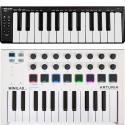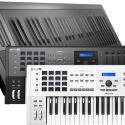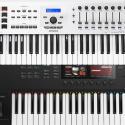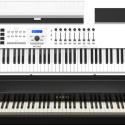How to Use MIDI Keyboard: Small Steps Towards Big Things
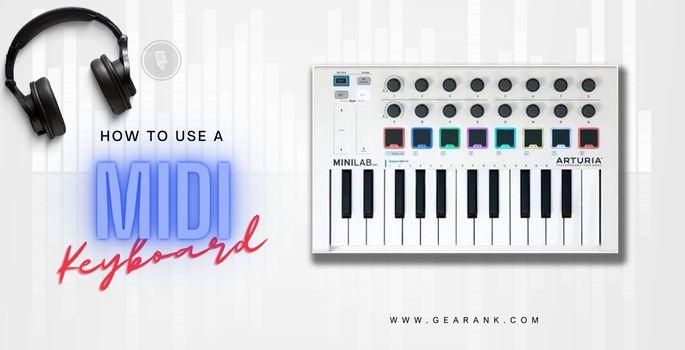
MIDI has revolutionized music production and live performance. And for many music artists, their first introduction to MIDI was with a MIDI keyboard.
So, if you're new to MIDI, learning how to use MIDI keyboard controllers is the best way to get started, whether you want to produce music, play music, or experiment with VSTs.
This guide will tell you how.
Below, I run through what MIDI stands for, where MIDI is used, how to start playing a MIDI keyboard, and more.
And if you own a keyboard (as in, a computer keyboard), you can start using MIDI for music making right away. How? Some DAWs allow you to use your regular keyboard to input MIDI.
Define MIDI
So what is MIDI? MIDI is a technology that lets electronic musical instruments communicate with one another. MIDI stands for "musical instrument digital interface," a feature you'll find nowadays on most modern music hardware.
Just some of these modern MIDI devices include:
-
MIDI keyboards
-
synthesizers
-
drum pads,
-
digital keyboards
-
digital pianos
MIDI data serves several purposes. It can be used for playing and making music, triggering samples and effects, and even stage lights during live performances.
All kinds of musicians, from bedroom music producers to professional DJs, are now taking advantage of the world of MIDI technology.
It's powerful and versatile and has become just as common and popular as playing any instrument.
What Is A MIDI Keyboard?
A MIDI keyboard is an electronic keyboard that can communicate using MIDI. This makes them more versatile than regular keyboards and vintage synthesizers, as they can connect to other electronic audio devices.
What's important to know is that without proper MIDI inputs or USB connection, a MIDI keyboard won't make a sound like a real piano or keyboard.
This is because they rely on a computer or other MIDI gear as their sound engine. They also don't have built-in speakers.
To make music, it has to be connected to virtual instruments, typically through a digital audio workstation (DAW) like Logic Pro X, Ableton Live, and FL Studio.
But despite not making sound on their own, MIDI keyboards can also feature knobs and other controls for more creativity and control when making an electronic music track.
As for how many keys they have, the number can be anything from 25 keys to 88 keys, depending on the size needed.
They can also have semi weighted keys or weighted keys.
What Is A MIDI Keyboard Used For?
MIDI keyboards are MIDI controllers. They won't produce sound independently (since they do not have speakers).
But they can be used to control various parameters and make music when connected to virtual instruments and other software.
In other words, the audio is produced from an external source (a VST) and external audio output (speakers or headphones) but played in real-time using the keys.
And the keys can be used to play different sounds depending on the virtual instrument used. This includes synthesized sounds, real instrument sounds, drums, vocal samples, and more.
Once assigned, the notes can be played in pitch like a regular keyboard.
And it can also be used to record your key presses into DAW piano rolls as a MIDI track. This is a saveable file that contains MIDI notes (songs notation) and MIDI instrument data that you can play as audio tracks.
How To Use MIDI Keyboard
So how do you set up and use a MIDI keyboard? The first step is to successfully connect your MIDI keyboard to a MIDI software, such as virtual instruments found in most digital audio workstations.
This connection is achieved using a MIDI cable. An example MIDI setup is connecting the MIDI keyboard to a computer via a MIDI interface or audio interface.
These interfaces usually connect to the USB ports of a computer via a USB cable.
What's worth mentioning is that a MIDI cable requires an input and output, i.e., two MIDI cables, which must run from the MIDI ports (MIDI in / out) of both devices.
Newer controllers may no longer have MIDI input and MIDI out, relying instead on modern USB cables and USB ports.
The next step is to ensure your MIDI keyboard communicates with your computer software. Most DAWs, like Logic Pro, will detect most MIDI keyboards connected to your USB port.
DAW software can also assign the keys automatically. But if not, you'll need to open the settings of your USB MIDI interface, USB audio interface, or DAW.
Once you connect it to your computer, load any virtual instrument and press the keys or pads.
These virtual instruments can emulate instruments, like a grand piano or classical music strings, or create unique synthesized audio using waveforms, envelopes, filters, and effects.
The Different Types Of MIDI Keyboard
MIDI keyboards are all different. They come in different sizes and can also feature drum pads, knobs, pitch bend, and other controls in addition to keys. The number of keys varies, with options that include:
-
25 keys
-
32 keys
-
49 keys
-
61 keys
-
88 keys
Also worth knowing is that a regular keyboard can also use MIDI.
This separates MIDI keyboards from keyboards with MIDI, as unlike a MIDI keyboard, a standard MIDI-compatible keyboard can produce sound on its own.
Even computer keyboards can use MIDI.
This involves playing the computer keys like a keyboard but without MIDI cables (depending on the DAW) for the same musical purposes as a MIDI keyboard.
MIDI Keyboards vs Digital Pianos
If you're considering getting a MIDI keyboard, something you might have come across is whether to get a MIDI keyboard or digital piano.
Digital pianos can also feature a MIDI connection, but the difference between the two is simple.
A MIDI keyboard doesn't have built-in sounds or speakers, so it won't play any sound unless you connect it to software.
A digital piano, on the other hand, has built-in piano sounds and speakers so that you can play it like a regular piano and connect it with MIDI software.
Another difference is the keys. A Digital Piano will typically have fully weighted keys to feel like a grand piano (despite the audio being a digital version), unlike a MIDI keyboard, which will usually be semi-weighted.
What Is A MIDI Controller?
A MIDI keyboard is a type of MIDI controller, but not every MIDI device is a MIDI keyboard.
So, what are MIDI controllers?
The simple answer is that they are any device with pads, knobs, or touchscreen that can send and receive MIDI messages.
This includes drum pads, effects processors for editing audio, audio samplers, etc. MIDI information is even used for controling light fixtures, which is useful for live performances.
All in all, what ultimately distinguishes each device is that a MIDI keyboard has keys, while a MIDI controller is an umbrella term for a device that controls software or hardware via MIDI signals.
Conclusion
It's a moderate learning curve, but thankfully, learning how to use MIDI keyboard controllers is easy enough for beginners.
You'll need to install the right software—a DAW with VST instruments—and connect each other using the proper hardware and cables.
After that, it's a matter of experimenting with the instrument library and plugins.
Remember that MIDI instruments don't have built-in audio, so you'll need an audio output, such as speakers, monitors, or headphones, to hear what's being played in your DAW or hardware synthesizer.




